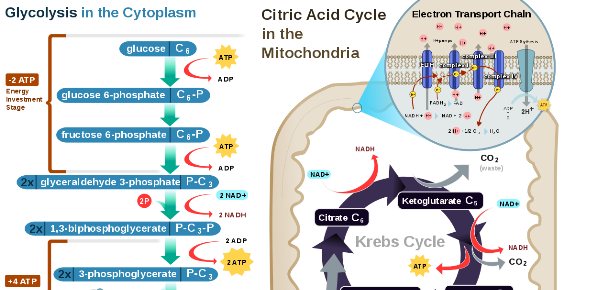Is Cellular Respiration Your Forte? Find Out With This Quiz!

Questions and Answers
- 1.
What is the first stage of cellular respiration?
- A.
Fermentation
- B.
Kreb's cycle
- C.
Glycolysis
- D.
Electron transport
Correct Answer
C. GlycolysisExplanation
Glycolysis is the first stage of cellular respiration. It is a metabolic pathway that occurs in the cytoplasm of cells and involves the breakdown of glucose into two molecules of pyruvate. This process does not require oxygen and is therefore considered anaerobic. Glycolysis produces a small amount of ATP and NADH, which can be used in later stages of cellular respiration to generate more energy.Rate this question:
-
- 2.
Energy is made during respiration in the form of what?
- A.
NADPH
- B.
ATP
- C.
Pyruvic acid
- D.
Glucose
Correct Answer
B. ATPExplanation
During respiration, energy is produced in the form of ATP (adenosine triphosphate). ATP is a molecule that stores and releases energy in cells. It is often referred to as the "energy currency" of the cell because it provides the necessary energy for various cellular processes, such as muscle contraction, active transport, and synthesis of macromolecules. NADPH, pyruvic acid, and glucose are also involved in energy production, but ATP is the primary form in which energy is made during respiration.Rate this question:
-
- 3.
Which stage of cellular respiration does not need oxygen?
- A.
Glycolysis
- B.
Kreb's cycle
- C.
Electron transport chain
- D.
Option 4
Correct Answer
A. GlycolysisExplanation
Glycolysis is the stage of cellular respiration that does not require oxygen. It is the initial step in breaking down glucose to produce energy. During glycolysis, glucose is converted into pyruvate, generating a small amount of ATP and NADH. This process occurs in the cytoplasm of the cell and can take place in both aerobic and anaerobic conditions.Rate this question:
-
- 4.
During which stage of cellular respiration is most of the ATP generated?
- A.
Glycolysis
- B.
Kreb's cycle
- C.
Electron transport chain
- D.
Fermentation
Correct Answer
C. Electron transport chainExplanation
The electron transport chain is the stage of cellular respiration where most of the ATP is generated. This process occurs in the inner mitochondrial membrane and involves the transfer of electrons from NADH and FADH2 to a series of protein complexes. As the electrons move through these complexes, energy is released and used to pump protons across the membrane, creating an electrochemical gradient. This gradient is then used by ATP synthase to produce ATP. Overall, the electron transport chain is highly efficient in generating ATP, making it the stage where most of the energy is produced.Rate this question:
-
- 5.
Where does the Kreb cycle occur?
- A.
Cytoplasm
- B.
Matrix of mitochondria
- C.
Chloroplast
- D.
Endoplasmic reticulum
Correct Answer
B. Matrix of mitochondriaExplanation
The Kreb cycle, also known as the citric acid cycle, occurs in the matrix of the mitochondria. This is where the majority of the chemical reactions of the cycle take place. The matrix is the innermost compartment of the mitochondria and contains enzymes and other molecules necessary for the Kreb cycle to occur. The cycle is an important part of cellular respiration, producing energy-rich molecules such as ATP that the cell can use for various metabolic processes.Rate this question:
-
Quiz Review Timeline +
Our quizzes are rigorously reviewed, monitored and continuously updated by our expert board to maintain accuracy, relevance, and timeliness.
-
Current Version
-
Mar 20, 2023Quiz Edited by
ProProfs Editorial Team -
Apr 06, 2015Quiz Created by
Esharma97
 Back to top
Back to top


